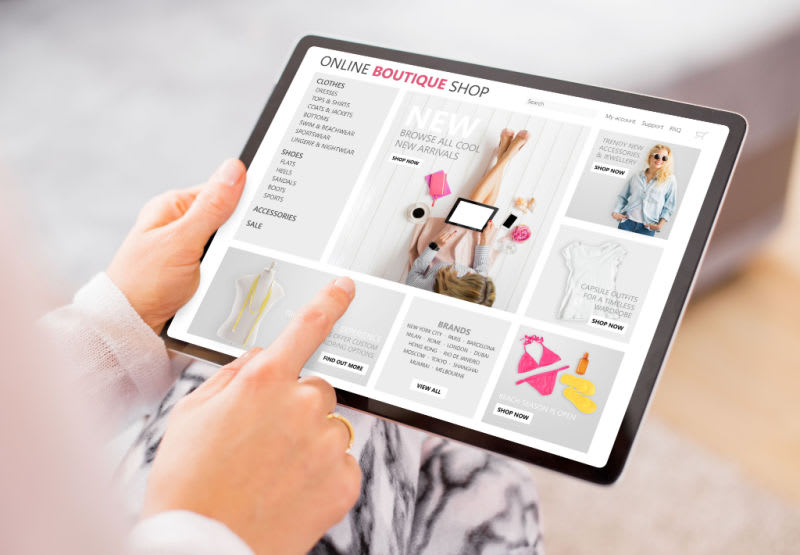How to Start an Online Boutique: A Step by Step Guide (2024)
In this article, we'll take you through the step-by-step process to create an online boutique so you can launch your new venture quickly and easily.
 December 7, 2023
December 7, 2023 13 minute reading
13 minute reading
As businesses made the transition online during the COVID-19 pandemic, the global digitization movement accelerated at a breakneck pace. Global eCommerce sales are estimated to surpass $5 trillion in 2022, rising to a record-breaking $6 trillion by 2024.
With more people shopping online than ever before, opening an online boutique is an excellent side hustle or full-time business opportunity.
Getting started is simple, but having all of the components in place for a successful online boutique takes time. In this article, we'll take you through the step-by-step process to create an online boutique so you can launch your new venture quickly and easily.
Step 1. Come up with an idea for your online boutique business
Once you decide you want to open an online boutique, your very first step will be to determine what you want to sell.
Choosing a niche for your online boutique is extremely important, as it dictates not only what you will sell, but also who your target consumers will be. A niche is a specialized sector of the market devoted to a specific type of product or service.
To discover the ideal niche for your online boutique, ask yourself the following:
What are you passionate about?
What hobbies or interests do you pursue in your spare time?
What regularly frustrates you?
What can you offer that is different to the products or services already being sold?
Pursuing overcrowded markets is one of the biggest mistakes entrepreneurs make when choosing their niche. Your niche must have a dedicated audience, but it also has to stand out in order to thrive in a crowded market.
Just be careful not to make your niche too specific, otherwise you could limit your audience too much and fail to have enough demand.
Some examples of online boutique niches include:
Knitwear made out of recycled yarn
A clothing brand specializing in garments for tall women
Jewelry made from recycled materials
Healthy treats for dogs
Sustainable and eco-friendly cleaning products
Organic makeup designed for acne-prone skin
Small-batch, handcrafted ceramics
One of the most important factors for success in eCommerce is having an in-depth understanding of your target market. Therefore, focusing on a smaller sector of the market also allows you to get to know your consumer base inside and out.
2. Do some market research to see if there is a demand for your product
You might have an amazing idea for a product to sell in your online boutique, but unless you conduct market research, it may never get off the ground. Market research is important because it will tell you if your new business idea has any potential, who your target audience is, and how you should position yourself in the market to maximize sales.
Closely examine the market and its relevant data
To figure out if there's a need for your product or service, you must first determine whether there are people who want it. This means looking at the current market and figuring out how big it is, how fast it's growing (or shrinking), and what percentage of this market can't be served by existing products or services.
This will give you insights into whether your product is something that people are currently looking for and whether they'll be willing to spend money on it.
When making these calculations, be sure to look at data in numerical terms, rather than just impressions. For example, saying "this product will solve this problem" isn't enough; you need to back up that assertion with statistics showing how many people have this problem in the first place.
Conduct keyword research relating to your product or niche
This can be done through Google Keyword Planner, Google Trends, and other keyword research tools.
For example, if your online boutique sells women’s clothing, then you would enter keywords such as “Women's Clothing” and “Women's Fashion” into the Google Keyword Planner tool to determine the demand for those terms in your city or country.
Keyword research can also determine the demand for specific keywords related to an item that you want to sell on your online boutique. A word of caution though: don't choose phrases that are too long or obscure because they may not produce enough traffic. Additionally, don't choose a single, generic phrase such as "women's scarves" either, as this is too broad. Instead, your keyword research may determine that combining your relevant keywords into a single phrase, such as "women fashion scarf", provides a better opportunity for high search demand, yet lower competition.
If you don’t have any experience in this field, you can hire the help of a freelance keyword research expert to obtain this information for you.
Perform a SWOT Analysis
A SWOT analysis is a method that helps you determine your online boutique's strengths, weaknesses, and opportunities in relation to its competitors. It can also be used to identify threats, such as components of your market research that could negatively affect your ecommerce business if not addressed.
To perform a SWOT analysis, write down all the factors that will have an impact on your business. These include:
Strengths: What makes your online boutique stand out from other jewelry, lifestyle, or clothing businesses? How are you better than others at providing products? What does your online boutique have that no one else does? For example, being able to offer same-day delivery for customers might be a strength for an online boutique selling clothes and accessories.
Weaknesses: What things do you need to work on in order to succeed as an online boutique owner? Are there things that might hold back customers from buying more often (such as slow shipping times)? Make sure these items are listed so they can be addressed once the market research has been completed successfully.
Opportunities: How can new opportunities help increase sales, improve customer satisfaction, and ultimately grow your online boutique? Think of opportunities for collaboration or seasonal events you can benefit from.
Threats: What are the biggest threats to your online boutique's success? For example, if another online retailer with a similar niche opens up and offers better prices on products or lower-cost shipping, that could put a dent in your sales figures.
Create Buyer Personas
A buyer persona is a fictional character that represents your ideal customer. By creating a buyer persona, you'll be able to understand what motivates your customers, how they search for products like yours, and what information they need before making a purchase decision. You'll then be able to create targeted marketing campaigns that speak directly to your target audience.
To create your buyer persona:
1. Think about who your ideal customer is: What do they do for a living? Where are they located? What kind of lifestyle do they lead? How much money do they make? What kind of education do they have? What are their hobbies? How old are they? What is their gender? What's their relationship status?
2. Think about how your ideal customers spend their time: What websites do they visit, what magazines do they read, or what social media platforms do they follow?
Once you've figured out all of these details about your ideal customers, write them down in an organized list or spreadsheet so you can easily refer back to them as needed.
Step 3. Set up your business structure
Next, the fun part. You’ll need to set up the legal stuff associated with your business.
Decide on the type of business: You have several options, but the two most common for first-time entrepreneurs are sole proprietorship and limited liability company (LLC). A sole proprietorship is the simplest form, but it leaves your personal assets vulnerable. In contrast, an LLC provides a safety net between your business debts and personal assets, which can be especially valuable as you navigate the unpredictable waters of a new business.
Understand sales tax: If you're going to sell online, you need to understand how sales tax works. The requirements can vary depending on where your customers are located and where you're operating your business from. You'll need to look into the specific regulations for your area and ensure you're collecting the right amount from customers, then remitting this back to the IRS.
Open a business bank account: This is a non-negotiable step. A business bank account not only helps you manage your finances professionally but also reinforces the legal distinction between your personal and business assets, particularly important if you're operating as an LLC.
Get a business credit card: Similar to a bank account, a business credit card helps you keep personal and business expenses separate. It can also be a short-term lifesaver when it comes to cash flow, but be cautious and manage it responsibly to avoid debt that could spiral.
Step 4. Find a reliable supplier
Finding credible wholesale suppliers at a reasonable price is very important when creating an online boutique. As a result, your goal should be to find a supplier or wholesaler who provides high-quality items, timely delivery, and outstanding customer service.
If you’ll be making the products to sell in your online boutique, then you’ll want to research suppliers that offer the materials or items you need for production. SaleHoo, Etsy Wholesaler, AliExpress, and sellers on eBay are just some of the more popular supplier options for boutiques specializing in handmade products.
Alternatively, you might choose to purchase ready-made products in bulk through wholesale, then sell these through your own online boutique. Some of the most well-known wholesale product suppliers include Alibaba, DHgate, and AliExpress.
If you’d rather sell products through your online boutique but without the need to take care of storage, packaging, or shipping, then you might consider dropshipping. This model allows you to sell another supplier’s products through your own online boutique. You never physically handle the product yourself, but instead, facilitate the order and earn money from doing so.
If you choose to go down the path of dropshipping, you still need to find a reliable supplier with high-quality products and swift delivery.
Before selecting a supplier for your online boutique, be sure to do your homework. Examine the supplier's background and reputation by reading customer reviews, and make sure the company has a point of contact in case you experience any problems.
Step 5. Create a business plan
The next step is to write a business plan for your online boutique. This will be your guide that outlines your goals and the measures you'll take to accomplish them.
A business plan can also assist you in tracking your progress, evaluating the feasibility of your online boutique, understanding your customers and competitors, and securing finance if required down the track.
Your business plan should include sections such as:
Executive summary
Company description
Business model and goals
Organizational and management structure
Products or services
Marketing and sales plan
Funding requirements
Financial plan and projections
Business licenses required
We’ve written an in-depth guide to creating a business plan to further assist you. If you need additional help, however, then a freelance business plan writer can get the job done for you.
Step 6. Choose a business name and logo
The name and logo of your online boutique can have a significant impact on how the public views your brand. Furthermore, your name and logo establish an identity that, when carefully chosen, assists you in building brand awareness and creating a strong presence within your niche.
When choosing a name for your online boutique, keep the following tips in mind:
Select a name that is unique and memorable: make sure your chosen name isn’t already in use. Additionally, research other brands within your industry to ensure your name isn’t too similar to others.
Keep it short and sweet: Some of the most successful brands stick to names containing just two to three syllables. Apple, Google, and Instagram are just three famous examples.
Avoid names that are easy to incorrectly pronounce or spell: You risk damaging your brand’s success if your customers can't locate you online or share your name with their friends.
Pitch potential names to your friends, family, or target consumers: Doing so will allow you to judge their reactions and gain valuable feedback from other parties.
Your online boutique’s logo is just as important as the name you choose. It forms one of the most important aspects of your business's branding and visual storytelling. Without one, your online boutique is left without a face for customers to recognize.
The following tips can help you choose the right logo for your online boutique:
Think about the emotions and values you want your brand to convey and how these can be represented through your logo’s shape, symbols, or color palette.
Research your competitors to ensure your logo isn’t too similar to an existing one. Additionally, try to determine what logo trends already exist in your chosen niche and how you can adapt these for your own brand.
Balance detail with simplicity. A complex logo is difficult to recall, but the ideal design is instantly identifiable and memorable. Complicated logos are especially difficult to duplicate properly when shrunken for stationery or mobile devices, or when they have to be stitched onto garments.
Consider the various mediums which will feature your logo. Email signatures, business cards, websites, and social media platforms are all examples of this. Additionally, consider all of the physical goods your logo may be printed on, such as product packaging or clothing. Will your design work in all of these formats?
For those without graphic design expertise, consider hiring a freelance logo designer to create a unique logo for your online boutique. Alternatively, you can use Fiverr’s Logo Maker, which utilizes artificial intelligence (AI) technology to take the guesswork out of logo creation. Simply input a few details about your brand and it generates dozens of professional logo ideas made by professional Fiverr sellers that are best suited to your online boutique.
Step 7. Come up with a domain name
Choosing a domain name for your online boutique is another important decision you'll make during the initial stages of your venture. To come up with the best possible domain name for your brand, consider the following:
Make it easy to remember
You want consumers to be able to remember your website address without having to write it down or think about it too hard. Therefore, make sure your domain name is both memorable and easy to spell.
Ensure it's available
Make sure that whatever domain name you're thinking of using isn't already taken by someone else. Start by searching around online before settling on any particular one.
This availability also extends to social media. If you can use the same domain across platforms, social media marketing will be more successful. Check to see if the domain you want is available on any social media sites you want to use.
Register your chosen domain name
There are several platforms through which you can purchase your domain name. One of the most well-known is GoDaddy.com, but other popular options include Dreamhost, Domain.com, and Bluehost.
To avoid losing potential visitors, some small business owners also purchase additional extensions and redirect them to their main site. This is particularly handy if your domain name has frequent misspellings, or you want to avoid competitors purchasing similar domain names.
Step 8. Create an ecommerce website for your boutique
To get started selling products through your online boutique, you'll first need to set yourself up on an eCommerce platform.
You have the option of using a hosted platform, which provides an all-in-one solution for building and managing your business, or an open source platform, which takes a little more technical know-how to configure and maintain. Open source platforms offer significantly more customization opportunities than hosted platforms, however.
Which platform should you choose?
The platform you select will dictate the features and performance of your online business, so be sure it has the tools you require to manage your store.
Three of the most popular options for setting up your online boutique include:
WordPress
Contrary to popular belief, WordPress isn’t just for blogs. The platform also has the capabilities to host eCommerce stores too, thanks to a free plugin called WooCommerce.
WooCommerce provides an on-screen setup wizard that will lead you through the entire online boutique setup process. The process is quite straightforward and only takes a few minutes.
Shopify
Shopify is a great place to start for those creating their own online boutique. It offers both a drag-and-drop website builder, as well as eCommerce capabilities for selling your own products like payment gateways and web hosting. Shopify also integrates with plenty of other apps, allowing you to optimize your online boutique in additional ways.
Magento
Magento, as opposed to a drag-and-drop website builder, makes use of open-source technology. This allows customers to utilize code to manage the design, functionality, and content of their online boutique.
It does, however, mean that those without coding experience may find the platform difficult to use.
If you need assistance in creating your online boutique’s website or online store, then you can order ecommerce development services from our freelance web developers and designers.
Step 9. Use these marketing strategies to promote
Once your online boutique has been launched, it’s time to start marketing it so you can boost your brand awareness and increase your customer base. Two of the most effective ways to do this are through sharing relevant content on your website and social media, as well as partnering with other, like-minded brands.
Create content for your website and social media
Creating original content for your site is key to getting traffic and building trust with potential customers. This includes blog posts about trends in your industry, product reviews, or tips for online shopping. Your goal should be to create a mix of content that's both interesting and informative for prospective customers—and then promote it across all of your channels. This includes creating video content and sharing images that showcase the products you sell.
Partner with other brands
Another great way to boost traffic and sales is by partnering with other brands in your space. For example, if you're selling women's apparel in your online clothing store, consider partnering with an influencer who has an audience that would be interested in these products. Also consider running promotions together where each brand offers something unique, like free shipping or discounts on specific items.
This helps build your credibility as an expert in your field, while also getting your name out there in a different way than simply using social media alone.
Leverage email marketing
You can grow your online clothing boutique using email marketing in a few smart ways. First, you can grab customers' attention by offering special deals or sneak peeks at new products if they sign up for emails.
You can also send out fun and friendly messages that share style tips, special sale info, and cool behind-the-scenes looks to keep subscribers excited about the brand. By checking which emails people liked most, you can keep getting better at sending stuff that customers will love and want to buy.
Invest in SEO
Search engine optimization (SEO) helps online boutiques craft captivating product descriptions that draw in new customers. A good SEO strategy will make your boutique more visible in search engine results, attracting a broader audience.
Imagine you own an online boutique selling vintage-inspired dresses. Your target audience is fashion-forward individuals who love unique, retro styles. To use SEO, you'd start with keyword research to identify terms new customers might use when looking for your products. These terms include "vintage-inspired dresses," "retro dresses," "unique vintage dresses," or "1950s style dresses."
Next, write detailed, compelling descriptions for each dress you sell, incorporating your keywords. For instance, "Step back in time with this stunning 1950s style dress, featuring a classic A-line silhouette that accentuates any figure. Perfect for lovers of unique vintage dresses, this piece is a must-have for any retro-inspired wardrobe!"
Step 10. Measure your success and make changes as needed
Finally, it's time to examine your online boutique's data and analytics to figure out what works well and what doesn't.
Importantly, you’ll want to pay close attention to eCommerce metrics such as:
Conversion rate
Cost of customer acquisition
Average order value
Shopping cart abandonment rate
Site traffic
Bounce rate at checkout
If you need some assistance, consider hiring the services of a data analyst. Once this data has been analyzed, you can then make adjustments and improvements such as:
Displaying your best-selling items on your homepage
Trying out different product copy or pictures on pages that aren't performing well
Adjusting your cart in areas where customers tend to abandon it
Encouraging product reviews and consumer feedback
Experimenting with seasonal discounts and marketing, such as for Christmas, Halloween, Black Friday, etc.
Create your online boutique today
While creating your own online storefront from scratch can seem like a daunting task, it doesn’t have to be. From finding your niche and determining a brand name, to choosing a supplier, selecting an eCommerce platform, and more—all it takes is several important, but simple steps to get your own store up and running.
Remember, you don’t have to go through this process alone. There are thousands of experienced freelancers specializing in all of these tasks who would love to help out. This doesn't just make creating an online boutique quicker and easier, but can dramatically boost your chances of eCommerce success.


